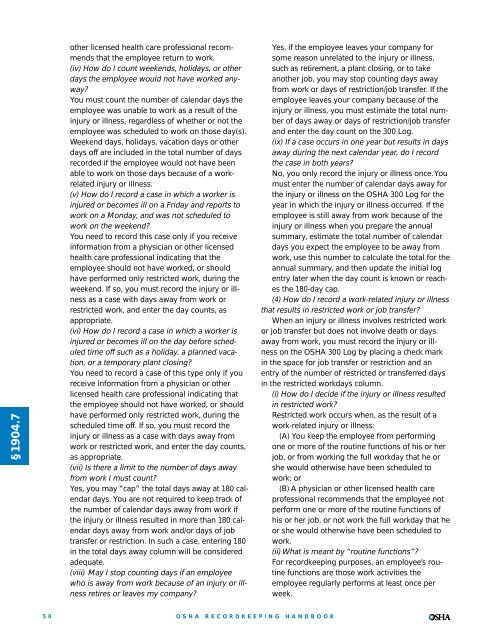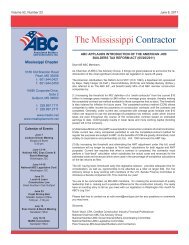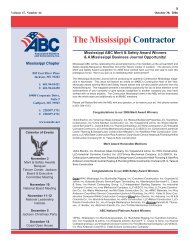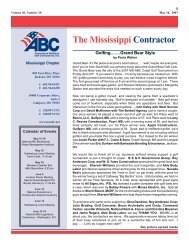§1904.7other licensed health care professional recommendsthat the employee return to work.(iv) How do I count weekends, holidays, or otherdays the employee would not have worked anyway?You must count the number of calendar days theemployee was unable to work as a result of theinjury or illness, regardless of whether or not theemployee was scheduled to work on those day(s).Weekend days, holidays, vacation days or otherdays off are included in the total number of daysrecorded if the employee would not have beenable to work on those days because of a workrelatedinjury or illness.(v) How do I record a case in which a worker isinjured or becomes ill on a Friday and reports towork on a Monday, and was not scheduled towork on the weekend?You need to record this case only if you receiveinformation from a physician or other licensedhealth care professional indicating that theemployee should not have worked, or shouldhave performed only restricted work, during theweekend. If so, you must record the injury or illnessas a case with days away from work orrestricted work, and enter the day counts, asappropriate.(vi) How do I record a case in which a worker isinjured or becomes ill on the day before scheduledtime off such as a holiday, a planned vacation,or a temporary plant closing?You need to record a case of this type only if youreceive information from a physician or otherlicensed health care professional indicating thatthe employee should not have worked, or shouldhave performed only restricted work, during thescheduled time off. If so, you must record theinjury or illness as a case with days away fromwork or restricted work, and enter the day counts,as appropriate.(vii) Is there a limit to the number of days awayfrom work I must count?Yes, you may “cap” the total days away at 180 calendardays. You are not required to keep track ofthe number of calendar days away from work ifthe injury or illness resulted in more than 180 calendardays away from work and/or days of jobtransfer or restriction. In such a case, entering 180in the total days away column will be consideredadequate.(viii) May I stop counting days if an employeewho is away from work because of an injury or illnessretires or leaves my company?Yes, if the employee leaves your company forsome reason unrelated to the injury or illness,such as retirement, a plant closing, or to takeanother job, you may stop counting days awayfrom work or days of restriction/job transfer. If theemployee leaves your company because of theinjury or illness, you must estimate the total numberof days away or days of restriction/job transferand enter the day count on the 300 Log.(ix) If a case occurs in one year but results in daysaway during the next calendar year, do I recordthe case in both years?No, you only record the injury or illness once. Youmust enter the number of calendar days away forthe injury or illness on the <strong>OSHA</strong> 300 Log for theyear in which the injury or illness occurred. If theemployee is still away from work because of theinjury or illness when you prepare the annualsummary, estimate the total number of calendardays you expect the employee to be away fromwork, use this number to calculate the total for theannual summary, and then update the initial logentry later when the day count is known or reachesthe 180-day cap.(4) How do I record a work-related injury or illnessthat results in restricted work or job transfer?When an injury or illness involves restricted workor job transfer but does not involve death or daysaway from work, you must record the injury or illnesson the <strong>OSHA</strong> 300 Log by placing a check markin the space for job transfer or restriction and anentry of the number of restricted or transferred daysin the restricted workdays column.(i) How do I decide if the injury or illness resultedin restricted work?Restricted work occurs when, as the result of awork-related injury or illness:(A) You keep the employee from performingone or more of the routine functions of his or herjob, or from working the full workday that he orshe would otherwise have been scheduled towork; or(B) A physician or other licensed health careprofessional recommends that the employee notperform one or more of the routine functions ofhis or her job, or not work the full workday that heor she would otherwise have been scheduled towork.(ii) What is meant by “routine functions”?For recordkeeping purposes, an employee’s routinefunctions are those work activities theemployee regularly performs at least once perweek.50<strong>OSHA</strong> RECORDKEEPINGHANDBOOK
(iii) Do I have to record restricted work or jobtransfer if it applies only to the day on which theinjury occurred or the illness began?No, you do not have to record restricted work orjob transfers if you, or the physician or otherlicensed health care professional, impose therestriction or transfer only for the day on whichthe injury occurred or the illness began.(iv) If you or a physician or other licensed healthcare professional recommends a work restriction,is the injury or illness automatically recordable asa “restricted work” case?No, a recommended work restriction is recordableonly if it affects one or more of the employee’sroutine job functions. To determine whether this isthe case, you must evaluate the restriction in lightof the routine functions of the injured or ill employee’sjob. If the restriction from you or thephysician or other licensed health care professionalkeeps the employee from performing one ormore of his or her routine job functions, or fromworking the full workday the injured or ill employeewould otherwise have worked, the employee’swork has been restricted and you must record thecase.(v) How do I record a case where the workerworks only for a partial work shift because of awork-related injury or illness?A partial day of work is recorded as a day of jobtransfer or restriction for recordkeeping purposes,except for the day on which the injury occurred orthe illness began.(vi) If the injured or ill worker produces fewergoods or services than he or she would have producedprior to the injury or illness but otherwiseperforms all of the routine functions of his or herwork, is the case considered a restricted workcase?No, the case is considered restricted work only ifthe worker does not perform all of the routinefunctions of his or her job or does not work thefull shift that he or she would otherwise haveworked.(vii) How do I handle vague restrictions from aphysician or other licensed health care professional,such as that the employee engage only in“light duty” or “take it easy for a week”?If you are not clear about the physician or otherlicensed health care professional’s recommendation,you may ask that person whether theemployee can do all of his or her routine job functionsand work all of his or her normally assignedwork shift. If the answer to both of these ques-tions is “Yes,” then the case does not involve awork restriction and does not have to be recordedas such. If the answer to one or both of thesequestions is “No,” the case involves restrictedwork and must be recorded as a restricted workcase. If you are unable to obtain this additionalinformation from the physician or other licensedhealth care professional who recommended therestriction, record the injury or illness as a caseinvolving restricted work.(viii) What do I do if a physician or other licensedhealth care professional recommends a jobrestriction meeting <strong>OSHA</strong>’s definition, but theemployee does all of his or her routine job functionsanyway?You must record the injury or illness on the <strong>OSHA</strong>300 Log as a restricted work case. If a physician orother licensed health care professional recommendsa job restriction, you should ensure thatthe employee complies with that restriction. If youreceive recommendations from two or morephysicians or other licensed health care professionals,you may make a decision as to which recommendationis the most authoritative, andrecord the case based upon that recommendation.(ix) How do I decide if an injury or illness involveda transfer to another job?If you assign an injured or ill employee to a jobother than his or her regular job for part of theday, the case involves transfer to another job.Note: This does not include the day on which theinjury or illness occurred.(x) Are transfers to another job recorded in thesame way as restricted work cases?Yes, both job transfer and restricted work casesare recorded in the same box on the <strong>OSHA</strong> 300Log. For example, if you assign, or a physician orother licensed health care professional recommendsthat you assign, an injured or ill worker tohis or her routine job duties for part of the dayand to another job for the rest of the day, theinjury or illness involves a job transfer. You mustrecord an injury or illness that involves a jobtransfer by placing a check in the box for jobtransfer.(xi) How do I count days of job transfer orrestriction?You count days of job transfer or restriction in thesame way you count days away from work, usingSection 1904.7(b)(3)(i) to (viii), above. The onlydifference is that, if you permanently assign theinjured or ill employee to a job that has beenmodified or permanently changed in a manner§1904.7<strong>OSHA</strong> RECORDKEEPINGHANDBOOK51
- Page 1 and 2:
www.osha.govOSHARecordkeepingHandbo
- Page 3 and 4:
OSHARecordkeeping HandbookThe Regul
- Page 5 and 6:
ContentsRecordkeeping HandbookRoadm
- Page 7 and 8: Section 1904.40Providing records to
- Page 9 and 10: Section 1904.0Purpose(66 FR 6122, J
- Page 11 and 12: Section 1904.1Partial exemption for
- Page 13 and 14: Section 1904.2Partial exemption for
- Page 15 and 16: employees, to OSHA within 8 hours (
- Page 17 and 18: Partial Exemptions for Employers Un
- Page 19 and 20: Section 1904.4Recording criteria(66
- Page 21 and 22: Section 1904.5Determination of work
- Page 23 and 24: (b)(7) How do I decide if a case is
- Page 25 and 26: well, including providing informati
- Page 27 and 28: This exception, which responds to i
- Page 29 and 30: or she is in the work environment a
- Page 31 and 32: have occurred but for the occupatio
- Page 33 and 34: considered work-related. If an empl
- Page 35 and 36: Question 5-12. Is work-related stre
- Page 37 and 38: • The doctor described the illnes
- Page 39 and 40: Scenario 7:• A site hired numerou
- Page 41 and 42: Letter of interpretation related to
- Page 43 and 44: These principles should be applied
- Page 45 and 46: The problem with the response is tw
- Page 47 and 48: Section 1904.6Determination of new
- Page 49 and 50: the Guidelines stated that “the a
- Page 51 and 52: estricted work. If the case is a pr
- Page 53 and 54: • The doctor also prescribed the
- Page 55 and 56: • The employees were under the di
- Page 57: Section 1904.7General recording cri
- Page 61 and 62: of the length of time the employee
- Page 63 and 64: then result in days away from work
- Page 65 and 66: A partial day of work is recorded a
- Page 67 and 68: In all other respects, the final ru
- Page 69 and 70: ments. The Agency believes that the
- Page 71 and 72: e recorded because it will require
- Page 73 and 74: However, episodes of fainting from
- Page 75 and 76: care professional, he or she may al
- Page 77 and 78: “Other simple means” of removin
- Page 79 and 80: For purposes of OSHA recordkeeping
- Page 81 and 82: • When answering the doctor’s q
- Page 83 and 84: Response: In the recordkeeping regu
- Page 85 and 86: Letter of interpretation related to
- Page 87 and 88: Section 1904.8Recording criteria fo
- Page 89 and 90: caused by contaminated needles and
- Page 91 and 92: Section 1904.9Recording criteria fo
- Page 93 and 94: Section 1904.10Recording criteria f
- Page 95 and 96: hearing loss case that is not relat
- Page 97 and 98: average of 10 decibels or more at 2
- Page 99 and 100: argued that because the function of
- Page 101 and 102: occurs, and where hearing loss can
- Page 103 and 104: cases in their workplace via analys
- Page 105 and 106: March 4, 2004Mr. Carl O. Sall, CIHD
- Page 107 and 108: When the professional evaluating th
- Page 109 and 110:
(2) May I line-out or erase a recor
- Page 111 and 112:
Section 1904.12Recording criteria f
- Page 113 and 114:
These new statistics would add only
- Page 115 and 116:
Sections 1904.13 - 1904.28 Reserved
- Page 117 and 118:
two lines of the OSHA 300 Log to de
- Page 119 and 120:
which replace the OSHA 200 and 101
- Page 121 and 122:
different types of occupational ill
- Page 123 and 124:
OSHA 301 form. These data are usefu
- Page 125 and 126:
LETTERS OF INTERPRETATION: Section
- Page 127 and 128:
Question 2: Under 29 CFR Section 19
- Page 129 and 130:
and has adopted language in the fin
- Page 131 and 132:
Section 1904.31Covered employees(66
- Page 133 and 134:
label assigned to a worker is immat
- Page 135 and 136:
These workers should be evaluated j
- Page 137 and 138:
Response: A case is work-related if
- Page 139 and 140:
Response: Section 1904.31 states th
- Page 141 and 142:
Thank you for your interest in occu
- Page 143 and 144:
year covered by the summary. The su
- Page 145 and 146:
2. Number of employees and hours wo
- Page 147 and 148:
LETTERS OF INTERPRETATION: Section
- Page 149 and 150:
Section 1904.33Retention and updati
- Page 151 and 152:
June 23, 2003Mr. Edwin G. Foulke, J
- Page 153 and 154:
Section 1904.34Change in business o
- Page 155 and 156:
PREAMBLE DISCUSSION: Section 1904.3
- Page 157 and 158:
Incident Report (Forms 300 and 301,
- Page 159 and 160:
workers’ compensation claim. See
- Page 161 and 162:
LETTERS OF INTERPRETATION: Section
- Page 163 and 164:
Letter of interpretation related to
- Page 165 and 166:
Question 3: Using the facts in Ques
- Page 167 and 168:
Section 1904.37State recordkeeping
- Page 169 and 170:
tion, require employers to report f
- Page 171 and 172:
(5) If I receive a variance, may th
- Page 173 and 174:
Section 1904.39Reporting fatalities
- Page 175 and 176:
gation. Therefore, the final rule d
- Page 177 and 178:
Section 1904.40Providing records to
- Page 179 and 180:
ness. The government inspector may
- Page 181 and 182:
Response: The controlling employer
- Page 183 and 184:
FREQUENTLY ASKED QUESTIONS: Section
- Page 185 and 186:
OSHA and the BLS have worked togeth
- Page 187 and 188:
provide copies of the retained reco
- Page 189 and 190:
FREQUENTLY ASKED QUESTIONS: Section
- Page 191 and 192:
Section 1904.46Definitions(66 FR 61
- Page 193 and 194:
of business information. For exampl
- Page 195 and 196:
inconvenience associated with keepi
- Page 197 and 198:
skin disease, respiratory disorder,
- Page 199 and 200:
Question 2: Under 29 CFR Section 19
- Page 201:
www.osha.gov







